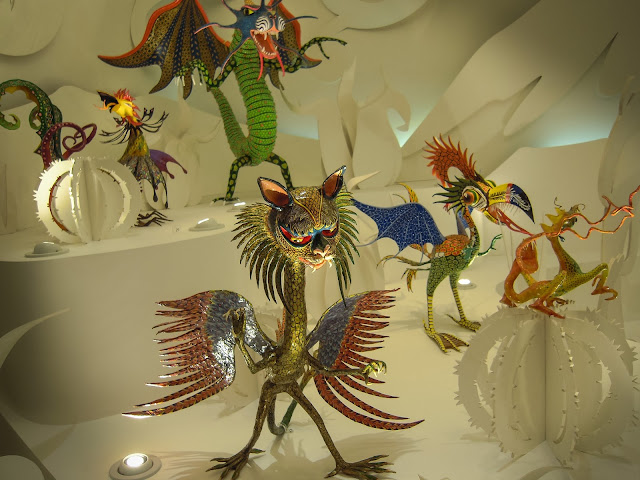Our Trip to Mexico City, Sixth and Final Day
Day 6 - It’s been another tough night for mi querida esposa y su enferma, but at least no worse than the one before, and tonight we’ll sleep in our own bed. We dawdle after awakening, shower and go downstairs to Starbucks for a familiar breakfast. Back upstairs we pack and tidy, then Salvador stores our bags so we can pick them up after visiting two nearby museums that will prove to be among our favorites from the whole viaje.
Museo Mural Diego Rivera primarily contains one monumental piece of work by the master—a fifty foot long by fifteen foot high mural entitled, in English, “Dream of a Sunday Afternoon in the Alameda Central”. Alameda is a Spanish word for tree-lined walkway referring to the park next to where we’ve been staying, and adjacent to the museum itself. It’s also a place where Diego Rivera used to play as a child, and where all of the mostly notable individuals pictured in the mural might have strolled or strode themselves at some time over the 400 years before it was completed in 1947.
As his title suggests, Rivera’s work invites comparison to Seuret’s iconic pointillist painting. The setting is similar, but the former piece is much less mannered and vastly more populated.
The mural is worthy of long contemplation. Even though it is immense and crowded, it is pleasing to the eye from a distance. The soft colors and sinuous branches of the park’s foliage in most of the top half of the painting contrast, yet balance, with the crush of humanity at the bottom. But more than anything, the detail and particularity of each individual portrait, as well as the interaction among them, invite close inspection and discovery.
“Dream of a Sunday Afternoon…” was originally a commission to hang in the restaurant of the elegant Hotel Prado but that building was damaged so heavily in the 1985 earthquake it had to eventually be demolished. The 70-ton mural with its plaster base and steel girding was rescued—pulled out a second story opening using casters and cranes, and trucked across the street to the museum that had been purpose-built to display it after restoration. What a sight that would have been!
As we leave the museum, and the Alameda Park itself, we recross the street and pass by the site of the old Hotel Prado where a modern Hilton now stands. In retrospect I’m amazed anew at how much history of consequence has passed on these grounds. At the time, though, we were just trying to keep it together until we got on the plane for home.
Next stop is the last stop: Museo de Arte Popular. Whereas the previous art works we have visited were completed by masters whose names are well-known—Kahlo, Siqueiros, Rivera, Orozco—the pieces we see now are created by virtually anonymous craftspeople, but no less accomplished for that. They are most often much smaller than the grand works mentioned previously, thus requiring less expense in materials and hired help, but their imagination and execution do not take a back seat.
 |
| Greeting visitors to the Museum of Popular Art is this VW Bug completely covered in beadwork, both inside and out. The patterns recall Huichol Indian designs that are popular handcraft items. |
 |
| A variety of indigenous traditional dress, or ropa típica, from throughout the country. Many are still worn today. |
 |
| Wooden and ceramic pieces featuring El Diablo, either getting his way or being undone, are popular items. I regret I did not get the names of these artists. |
 |
| Colored paper and foil, yarn, and bric-a-brac are the mediums in this piece. Detail, below. |
 |
| Detail of above piece |
This final visit is a suitably surrealistic ending to our adventure in Mexico City. The flight home is thankfully short and Paolo, one of the Miramontes sons, greets us at the airport. The next day our dear, but bossy, housekeeper drives my ailing wife to our doctor who confirms her pneumonia. Now, nearly three weeks later, she is doing fine.
 |
| Along the jagged shoreline of Lago de Chapala, near where it meets the horizon, is our little village, and somewhere in its midst is our casa preparing to welcome us home. |






No comments:
Post a Comment